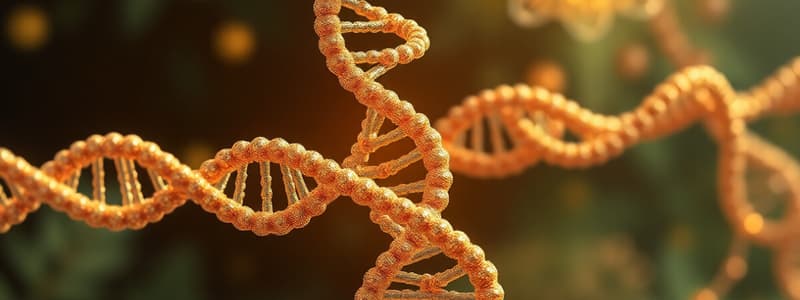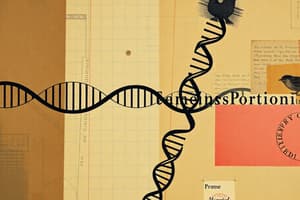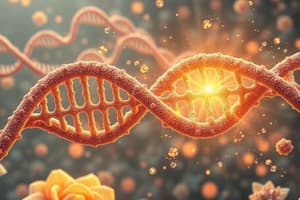Podcast
Questions and Answers
Why is only one strand of the double-stranded DNA helix used as a template for replication?
Why is only one strand of the double-stranded DNA helix used as a template for replication?
Using only one strand ensures accurate replication by providing a direct template, preventing errors that could arise from combining information from both strands. Using both strands would cause conflicting information.
How does the absence of a nucleus in mature red blood cells relate to their primary function?
How does the absence of a nucleus in mature red blood cells relate to their primary function?
The absence of a nucleus allows more space for hemoglobin, maximizing oxygen transport capacity. Also, without a nucleus, the red blood cell cannot divide.
Explain why prokaryotes do not require intron removal like eukaryotes.
Explain why prokaryotes do not require intron removal like eukaryotes.
Prokaryotes lack introns in their genes, thus intron removal is unnecessary. Their genes are continuous coding sequences.
Describe the role PolyA tail length plays in mRNA stability and translation.
Describe the role PolyA tail length plays in mRNA stability and translation.
Why is mRNA single-stranded while DNA is double-stranded?
Why is mRNA single-stranded while DNA is double-stranded?
What is the purpose of adding a modified guanine nucleotide (capping) at the 5' end of mRNA during processing?
What is the purpose of adding a modified guanine nucleotide (capping) at the 5' end of mRNA during processing?
How can alternative splicing of a single gene lead to the production of different proteins?
How can alternative splicing of a single gene lead to the production of different proteins?
Explain how mRNA degradation in the cytosol is related to the extent of protein synthesis.
Explain how mRNA degradation in the cytosol is related to the extent of protein synthesis.
Why do proteins with a membrane destination go to the Rough Endoplasmic Reticulum (RER)?
Why do proteins with a membrane destination go to the Rough Endoplasmic Reticulum (RER)?
If a mutation changed the start codon AUG to AUU in an mRNA, what would be the likely effect on translation?
If a mutation changed the start codon AUG to AUU in an mRNA, what would be the likely effect on translation?
Explain, generally, how a change in the amino acid sequence of a protein can alter its overall shape and function.
Explain, generally, how a change in the amino acid sequence of a protein can alter its overall shape and function.
Describe the role of pyrophosphatase in the context of nucleotide addition during DNA or RNA synthesis.
Describe the role of pyrophosphatase in the context of nucleotide addition during DNA or RNA synthesis.
During translation, what is the role of the small ribosomal subunit and the large ribosomal subunit?
During translation, what is the role of the small ribosomal subunit and the large ribosomal subunit?
How can some antibiotics that target protein synthesis in prokaryotes be ineffective against eukaryotic cells?
How can some antibiotics that target protein synthesis in prokaryotes be ineffective against eukaryotic cells?
Explain how a mutation in an enhancer region far from a gene can still impact protein synthesis.
Explain how a mutation in an enhancer region far from a gene can still impact protein synthesis.
Flashcards
Transcription
Transcription
RNA synthesis using a DNA template to code for a single strand.
Nucleus
Nucleus
A cellular component containing the cell's genetic material.
Introns
Introns
Non-coding sections of pre-mRNA that are removed during RNA splicing.
Polyadenylation
Polyadenylation
Signup and view all the flashcards
Promoter Region
Promoter Region
Signup and view all the flashcards
5' Capping
5' Capping
Signup and view all the flashcards
Cytosol
Cytosol
Signup and view all the flashcards
Translation
Translation
Signup and view all the flashcards
Start Codon
Start Codon
Signup and view all the flashcards
Stop Codons
Stop Codons
Signup and view all the flashcards
tRNA
tRNA
Signup and view all the flashcards
Antibiotics and Protein Synthesis
Antibiotics and Protein Synthesis
Signup and view all the flashcards
Termination Factors
Termination Factors
Signup and view all the flashcards
Ferritin
Ferritin
Signup and view all the flashcards
Mutation
Mutation
Signup and view all the flashcards
Study Notes
Central Dogma: DNA
- Nucleic acids are the biomolecule basis, specifically deoxyribonucleic acid (DNA) and ribonucleic acid (RNA).
- DNA forms the inherited genetic material inside cells, where segments known as genes code for protein synthesis and determine physical traits.
- DNA doesn't directly control protein synthesis but uses RNA as an intermediate.
DNA Structure: Nucleotides
- Nucleotides have three components.
- Nitrogenous bases come in two types: Purines (double-ring) and Pyrimidines (single-ring).
- DNA's 3D structure is a double helix.
- The sugar-phosphate backbone forms a right-handed helix, maximizing base-pairing efficiency.
- A complete turn occurs every 10 base pairs.
- Two DNA strands are held together by hydrogen bonds between bases: Adenine (A) pairs with Thymine (T), and Guanine (G) pairs with Cytosine (C).
- The number of purines must equal the number of pyrimidines to maintain the DNA double helix. - H bonds form between A and T, G and C.
- Forces needed to stabilize the DNA double helix are hydrogen bonds, the sugar-phosphate backbone, and base stacking: - Bases stack parallel and expel water through hydrophobic effects.
- Nucleotides are joined along the sugar phosphate backbone, this is known as phosphodiester bonds.
- Positively charged magnesium ions help stabilize the negative charges found in the sugar phosphate backbone.
DNA Condensation
- Nucleosomes, the structural unit for packaging DNA, consist of base pairs wrapped around a histone core known as protein octamer (H2A, H2B, H3, H4), and the H1 linker protein.
- Chromatin, a complex of tightly bound protein and DNA, exists as densely packed heterochromatin or dispersed euchromatin:
- Euchromatin being transcriptionally active.
- DNA is packaged into chromosomes in condensed form. Human cells typically have 23 pairs of chromosomes (46 total), with one copy from each parent, called diploid (2n).
- Maternal and paternal chromosome pairs are called homologous chromosomes.
- Autosomal chromosomes, numbered 1-22, form homologous pairs.
- Sex chromosomes determine biological sex:
- Females have two X chromosomes, while males have one X and one Y chromosome.
Genes
- Chromosomes carry genes that are the functional units of heredity.
- A gene is a DNA segment containing instructions for making a particular protein.
- An exon is a coding sequence of a gene.
- An intron is a non-coding sequence of a gene.
- Introns are removed via splicing after transcription.
- 98.5% of the human genome is non-coding DNA, playing regulatory roles.
- Promotor and enhancer regions bind transcription factors.
- Binding sites organize chromatin structures.
- Non-coding regulatory RNA includes microRNA.
- Certain mobile genetic elements called transposons, are implicated in gene regulation and chromatin.
Central Dogma: RNA
- RNA is a polymer of nucleotides linked by a phosphodiester bond, similar to DNA, but also different from DNA chemically in two ways.
- There is ribose sugar instead of deoxyribose sugar.
- Uracil (U) is used, rather than Thymine (T).
- Adenine, guanine, and cytosine is still contained within the bonds
Structural Difference
- Structurally, the molecules different.
- DNA always occurs in a double-stranded helix
- RNA is single-stranded
- This allows it to fold up into various shapes
Functional Difference
- mRNA is the template for protein translation.
- This is called messenger RNA.
- Initially called pre-mRNA.
- Undergoes processing before maturing. .Some DNA sequences transcribed into RNA are not tranlated into proteins
- This is called non-coding RNA.
- Serves as regulatory, structural and enzymatic structural components.
- snRNA, or small nuclear RNA is used in the spliceosome
- Necessary to remove introns in the pre-mRNA, then splicing occurs.
- Associates with protein subunits in order to form small nuclear ribonucleoproteins (snRNPs). This forms the core of the spliceosome.
Other forms of RNA
- rRNA stands for Ribosomal RNA
- Necessary for the basic structure of the ribosome
- It has a large (60S) and small (40S) subunit
- Involved in catalysis of the peptide bond between amino acids
- tRNA transfer RNA
- Needed in translation in order to carry the correct acid to the growing polypeptide change
- The unique clover leaf shape has two key components
- Anticodon, that pairs with the complementary code in it's mRNA
- Amino acid binding site, a short single-stranded region at the 3' end that binds the corresponding anti-codon on the tRNA
###Wobble Theory
- Theory: Despite there being 64 possible combinations of nucleotides in a 3 nucleotide codon ,there are only 20 amino acids
- There is more than one possible tRNA for many of the amino acids.
- This mean some molecules can pair with more than one codon
- This causes the wobble theory, where two tRNA are built to only require accurate pair of only the first two positions in a codon.
- These can tolerate mismatch and so many codons for an amino acid differ in their 3rd nucleotide.
###Non-coding other
- miRNA or micro RNA is non-coding and helps regulate expression via post-transcriptional silencing
- Prevents translation through promotion of degradation.
- siRNA is small interering RNA which works to express gene expression
- Through the direct degradation of mRNA.
- IncRNA are long- non-coding RNA, which express gene expression
- These help increase transcription
- Involved in X-chromosome
Class
- Chromosomes provide the functional unit of heredity.
- 1st and 2nd steps of Eukaryotic transcription are defined as.
- First the pre-mRNA will be transcribed.
- Then 3 main ways of protein will occur through processing.
RNA
- Transcription is a key process, using RNA made from a DNA molecules to help dictate of a protein is synthesized.
- Takes place inside of the Nucleus of a cell.
- Genes contains regulatory and Basal Promoter reasons, as well as transcription Start and EXONS
- Prokaryates do not have Introns.
- Coding reasons will transfer to RNA to help form transcription.
- RNA Polymerase is very significant as an enzyne to start transcription.
- It helps to unwind Double Helix to polymerization with a Phosphiester bond
- RNA Polymerase Il helps to to take form MRA
Basic information.
- Transcription has 3 basis step.
- Gerenal Transcription
- DNA to help startTranscription process.
- Then area must help start signials. -Enlongation
- RNS Polyremuse, catalzyes from addition to, prem RNA trancrpt
- This occurs for MRMA is single stranded -Temination
- pre—m RNA transfer and released from RNA polymease
- Then is the final release to RNS and DNRA polymeasie
- Gerenal Transcription
Studying That Suits You
Use AI to generate personalized quizzes and flashcards to suit your learning preferences.
Related Documents
Description
Explore fundamental concepts in molecular biology. This includes DNA replication, mRNA processing, protein synthesis and the impact of genetic mutations. Learn about the central dogma and gene expression.




